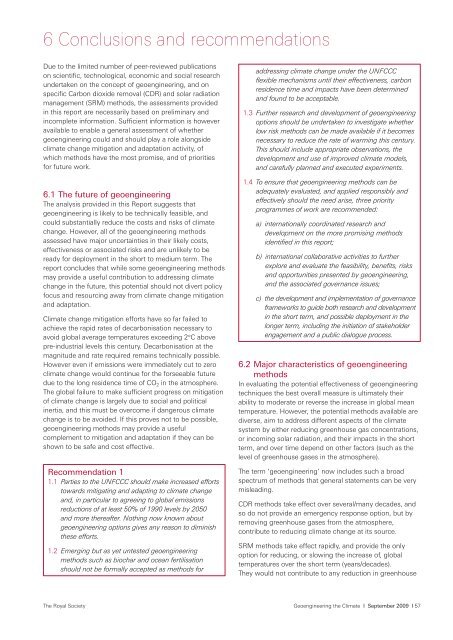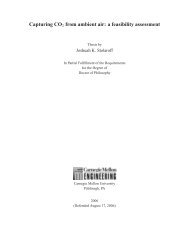Royal Society - David Keith
Royal Society - David Keith
Royal Society - David Keith
You also want an ePaper? Increase the reach of your titles
YUMPU automatically turns print PDFs into web optimized ePapers that Google loves.
6 Conclusions and recommendations<br />
Due to the limited number of peer-reviewed publications<br />
on scientific, technological, economic and social research<br />
undertaken on the concept of geoengineering, and on<br />
specific Carbon dioxide removal (CDR) and solar radiation<br />
management (SRM) methods, the assessments provided<br />
in this report are necessarily based on preliminary and<br />
incomplete information. Sufficient information is however<br />
available to enable a general assessment of whether<br />
geoengineering could and should play a role alongside<br />
climate change mitigation and adaptation activity, of<br />
which methods have the most promise, and of priorities<br />
for future work.<br />
6.1 The future of geoengineering<br />
The analysis provided in this Report suggests that<br />
geoengineering is likely to be technically feasible, and<br />
could substantially reduce the costs and risks of climate<br />
change. However, all of the geoengineering methods<br />
assessed have major uncertainties in their likely costs,<br />
effectiveness or associated risks and are unlikely to be<br />
ready for deployment in the short to medium term. The<br />
report concludes that while some geoengineering methods<br />
may provide a useful contribution to addressing climate<br />
change in the future, this potential should not divert policy<br />
focus and resourcing away from climate change mitigation<br />
and adaptation.<br />
Climate change mitigation efforts have so far failed to<br />
achieve the rapid rates of decarbonisation necessary to<br />
avoid global average temperatures exceeding 2∞C above<br />
pre-industrial levels this century. Decarbonisation at the<br />
magnitude and rate required remains technically possible.<br />
However even if emissions were immediately cut to zero<br />
climate change would continue for the forseeable future<br />
due to the long residence time of CO 2 in the atmosphere.<br />
The global failure to make sufficient progress on mitigation<br />
of climate change is largely due to social and political<br />
inertia, and this must be overcome if dangerous climate<br />
change is to be avoided. If this proves not to be possible,<br />
geo engineering methods may provide a useful<br />
complement to mitigation and adaptation if they can be<br />
shown to be safe and cost effective.<br />
Recommendation 1<br />
1.1 Parties to the UNFCCC should make increased efforts<br />
towards mitigating and adapting to climate change<br />
and, in particular to agreeing to global emissions<br />
reductions of at least 50% of 1990 levels by 2050<br />
and more thereafter. Nothing now known about<br />
geoengineering options gives any reason to diminish<br />
these efforts.<br />
1.2 Emerging but as yet untested geoengineering<br />
methods such as biochar and ocean fertilisation<br />
should not be formally accepted as methods for<br />
addressing climate change under the UNFCCC<br />
flexible mechanisms until their effectiveness, carbon<br />
residence time and impacts have been determined<br />
and found to be acceptable.<br />
1.3 Further research and development of geoengineering<br />
options should be undertaken to investigate whether<br />
low risk methods can be made available if it becomes<br />
necessary to reduce the rate of warming this century.<br />
This should include appropriate observations, the<br />
development and use of improved climate models,<br />
and carefully planned and executed experiments.<br />
1.4 To ensure that geoengineering methods can be<br />
adequately evaluated, and applied responsibly and<br />
effectively should the need arise, three priority<br />
programmes of work are recommended:<br />
a) internationally coordinated research and<br />
development on the more promising methods<br />
identified in this report;<br />
b) international collaborative activities to further<br />
explore and evaluate the feasibility, benefits, risks<br />
and opportunities presented by geoengineering,<br />
and the associated governance issues;<br />
c) the development and implementation of governance<br />
frameworks to guide both research and development<br />
in the short term, and possible deployment in the<br />
longer term, including the initiation of stakeholder<br />
engagement and a public dialogue process.<br />
6.2 Major characteristics of geoengineering<br />
methods<br />
In evaluating the potential effectiveness of geoengineering<br />
techniques the best overall measure is ultimately their<br />
ability to moderate or reverse the increase in global mean<br />
temperature. However, the potential methods available are<br />
diverse, aim to address different aspects of the climate<br />
system by either reducing greenhouse gas concentrations,<br />
or incoming solar radiation, and their impacts in the short<br />
term, and over time depend on other factors (such as the<br />
level of greenhouse gases in the atmosphere).<br />
The term ‘geoengineering’ now includes such a broad<br />
spectrum of methods that general statements can be very<br />
misleading.<br />
CDR methods take effect over several/many decades, and<br />
so do not provide an emergency response option, but by<br />
removing greenhouse gases from the atmosphere,<br />
contribute to reducing climate change at its source.<br />
SRM methods take effect rapidly, and provide the only<br />
option for reducing, or slowing the increase of, global<br />
temperatures over the short term (years/decades).<br />
They would not contribute to any reduction in greenhouse<br />
The <strong>Royal</strong> <strong>Society</strong><br />
Geoengineering the Climate I September 2009 I 57








